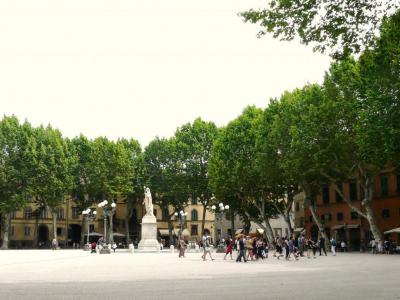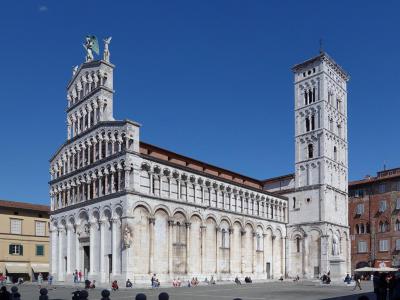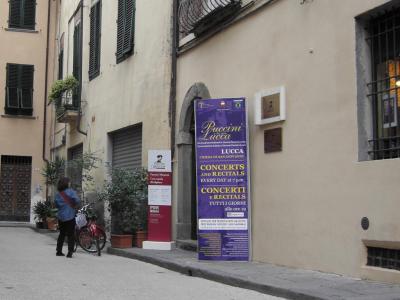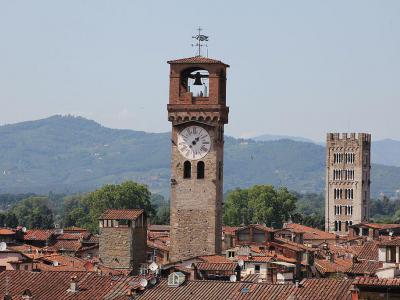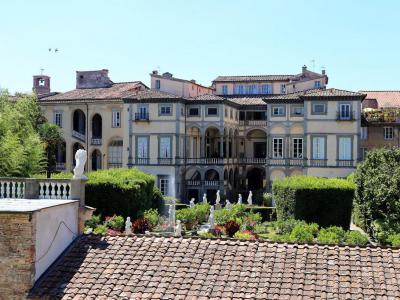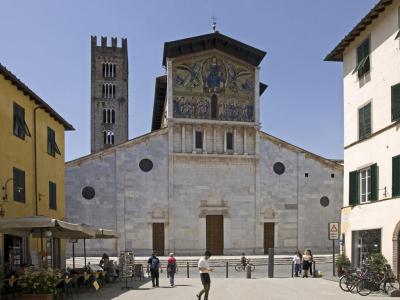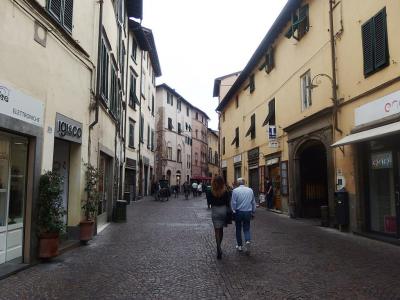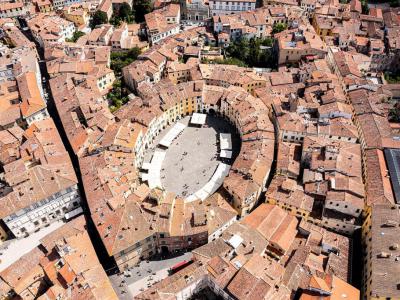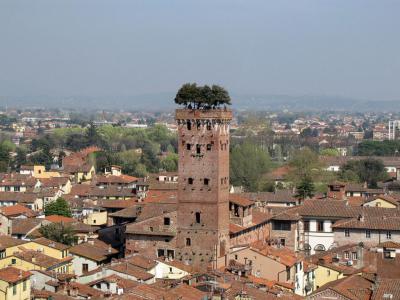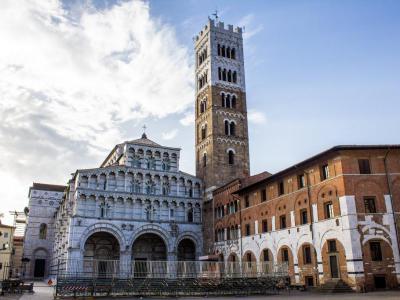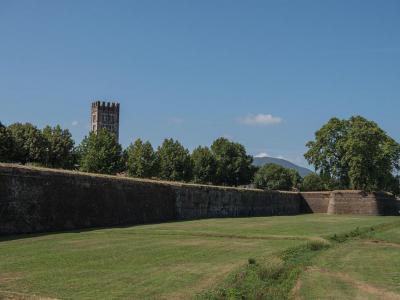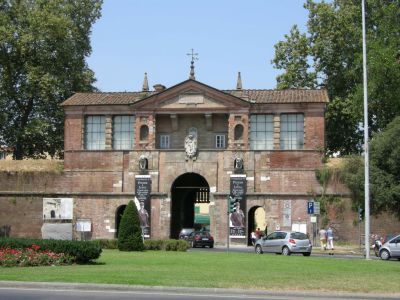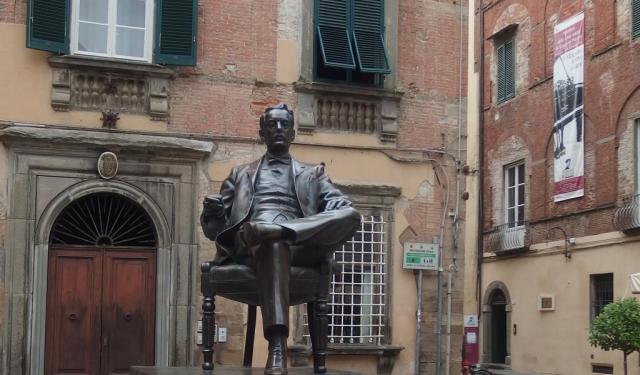
Lucca Introduction Walking Tour (Self Guided), Lucca
Lucca is called many things: a city of arts, a city of churches, gardens, towers. Most of all it is known for its walls. From Roman times until now the walls have stood. It is the only city in Italy that has kept its walls intact.
The inner walled city is laid out in the ancient Roman grid plan. The Piazza San Michele is the site of the old forum. Bits of the Roman amphitheater can be found in the Amphitheater Square (Piazza dell'Anfiteatro). In Lucca in 56 BC, Julius Caesar, Pompey and Crassus formed their first Triumvirate. Where they had their tete-a-tete in Lucca is unknown.
Lucca grew to prosperity in the silk trade of the 11th century. During the high middle ages the city was ruled by several dynasties. The last noble ruler was Matilda of Tuscany. After her death, the city became a chartered independent commune in 1160. Lucca remained as an independent republic for 500 years. The walls helped.
In 1805, Napoleon was Emperor, Lucca was declared a monarchy. It was ruled by Napoleon's sister, Elisa Bonaparte Baciocchi. Although Elisa and her brother were out of the picture in 1815, Lucca would not see independence again until 1861.
By the 19th century the walls were of little value as defense assets. The State required all city walls to be demolished. Lucca bought their walls from the central government. Today the walls don't repel. They attract. Walk the shaded passeggiata of the walls and take in the view.
Climb the town clock tower and/or the tree-topped Guinigi Tower. Take the hidden passageway leading to the Market Square, aka the Ampitheater Square. Visit Romanesque Lucca Cathedral. See San Michele in Foro, built in the 14th century on the site of the old Roman forum. The Church of San Frediano should not be missed.
Lucca is the hometown of great opera composer Giacomo Puccini. Music fans can look forward to the annual Lucca Summer Festival featuring famous artists of the world. Strolling along the chic Via Fillungo, try the stuffed tordelli, befanini biscotti, and traditional buccellato.
"Who comes to Lucca and doesn't taste the buccellato hasn't really been there."
The inner walled city is laid out in the ancient Roman grid plan. The Piazza San Michele is the site of the old forum. Bits of the Roman amphitheater can be found in the Amphitheater Square (Piazza dell'Anfiteatro). In Lucca in 56 BC, Julius Caesar, Pompey and Crassus formed their first Triumvirate. Where they had their tete-a-tete in Lucca is unknown.
Lucca grew to prosperity in the silk trade of the 11th century. During the high middle ages the city was ruled by several dynasties. The last noble ruler was Matilda of Tuscany. After her death, the city became a chartered independent commune in 1160. Lucca remained as an independent republic for 500 years. The walls helped.
In 1805, Napoleon was Emperor, Lucca was declared a monarchy. It was ruled by Napoleon's sister, Elisa Bonaparte Baciocchi. Although Elisa and her brother were out of the picture in 1815, Lucca would not see independence again until 1861.
By the 19th century the walls were of little value as defense assets. The State required all city walls to be demolished. Lucca bought their walls from the central government. Today the walls don't repel. They attract. Walk the shaded passeggiata of the walls and take in the view.
Climb the town clock tower and/or the tree-topped Guinigi Tower. Take the hidden passageway leading to the Market Square, aka the Ampitheater Square. Visit Romanesque Lucca Cathedral. See San Michele in Foro, built in the 14th century on the site of the old Roman forum. The Church of San Frediano should not be missed.
Lucca is the hometown of great opera composer Giacomo Puccini. Music fans can look forward to the annual Lucca Summer Festival featuring famous artists of the world. Strolling along the chic Via Fillungo, try the stuffed tordelli, befanini biscotti, and traditional buccellato.
"Who comes to Lucca and doesn't taste the buccellato hasn't really been there."
How it works: Download the app "GPSmyCity: Walks in 1K+ Cities" from Apple App Store or Google Play Store to your mobile phone or tablet. The app turns your mobile device into a personal tour guide and its built-in GPS navigation functions guide you from one tour stop to next. The app works offline, so no data plan is needed when traveling abroad.
Lucca Introduction Walking Tour Map
Guide Name: Lucca Introduction Walking Tour
Guide Location: Italy » Lucca (See other walking tours in Lucca)
Guide Type: Self-guided Walking Tour (Sightseeing)
# of Attractions: 12
Tour Duration: 2 Hour(s)
Travel Distance: 3.2 Km or 2 Miles
Author: Dee
Sight(s) Featured in This Guide:
Guide Location: Italy » Lucca (See other walking tours in Lucca)
Guide Type: Self-guided Walking Tour (Sightseeing)
# of Attractions: 12
Tour Duration: 2 Hour(s)
Travel Distance: 3.2 Km or 2 Miles
Author: Dee
Sight(s) Featured in This Guide:
- Piazza Napoleone (Napoleon Square)
- Church of San Michele
- Casa di Puccini (Puccini's Birth Home)
- Torre delle Ore (The Clock Tower)
- Palazzo Pfanner (Pfanner Palace)
- Church of San Frediano
- Via Fillungo (Fillungo Street)
- Piazza dell'Anfiteatro (Amphitheater Square)
- Torre Guinigi (Guinigi Tower)
- Duomo di San Martino (St. Martin's Cathedral)
- Lucca's City Walls (The Lucca Ramparts)
- Porta San Pietro (St. Peter's Gate)
1) Piazza Napoleone (Napoleon Square)
Lucca has always needed its walls. Castruccio Castracani, 14th century Duke of Lucca, built the huge Fortress Augusta, where the Napoleon Square is today.
The fortress was certainly huge, it covered one-fifth of the city. In 1370 The Council of Elders ordered it demolished. Paolo Guingini, Lord of Lucca in the 15th century, restored it as The Citadel of Lucca. Paolo was out of favor by 1429 and the Citadel joined the Fortress Augusta in the dustbin of history.
From the ashes of the Citadel arose the Ducale palace, which stands on the Napoleon Square today. The square was established in 1806 by Elisa Bonaparte Baciocchi, Napoleon's sister. Elisa had a statue in the Square built in honor of her brother, but by 1815 Napoleon was passe.
Napoleon's statue was replaced by one dedicated to Maria Luisa of Spain. She was more popular so her statue stayed.
The Square is a popular venue for concerts and events. Each summer the square hosts the Lucca Summer Festival, not to be missed.
The fortress was certainly huge, it covered one-fifth of the city. In 1370 The Council of Elders ordered it demolished. Paolo Guingini, Lord of Lucca in the 15th century, restored it as The Citadel of Lucca. Paolo was out of favor by 1429 and the Citadel joined the Fortress Augusta in the dustbin of history.
From the ashes of the Citadel arose the Ducale palace, which stands on the Napoleon Square today. The square was established in 1806 by Elisa Bonaparte Baciocchi, Napoleon's sister. Elisa had a statue in the Square built in honor of her brother, but by 1815 Napoleon was passe.
Napoleon's statue was replaced by one dedicated to Maria Luisa of Spain. She was more popular so her statue stayed.
The Square is a popular venue for concerts and events. Each summer the square hosts the Lucca Summer Festival, not to be missed.
2) Church of San Michele (must see)
The full name of the Church is San Michele in Foro. It was built in the Forum, the center of public life in the Commune of the City. The Church dates from 795 AD. Pope Alexander II ordered the Church rebuilt in 1070. The massive Pisan-Baroque facade resembles nothing less than a gigantic wedding cake.
There are four levels of arcades. The upper two tiers are free-standing loggias. The lower section is faced with white marble blind arcades. The center part of the upper facade has an iron-winged statue of St. Michael spearing the dragon. If one looks closely one may see the emerald on Michael's finger ring.
On the lower right corner of the facade is a statue of Madonna Salute Portus, Made by Matteo Civitali to mark the end of the plague of 1476.
The interior has two aisles and a nave and a transept design with a semicircular apse. The nave is supported by arcades with massive columns. There is a terra-cotta image of the Madonna and child by Andrea della Robbia. A painted mural by Filippo Lippi celebrates saints Helen, Rocco, Gerome, and Sebastian.
The bell tower was built in the 13th century. It rises over the southern transept of the building. The upper level of the tower was cut off in 1366 by the Doge of Pisa, Giovanni dell'Angello, because the bells were too loud.
The basilica is only a short walk from the Lucca train station. The nearest bus station is San Salvatore on the LAM Verde route.
There are four levels of arcades. The upper two tiers are free-standing loggias. The lower section is faced with white marble blind arcades. The center part of the upper facade has an iron-winged statue of St. Michael spearing the dragon. If one looks closely one may see the emerald on Michael's finger ring.
On the lower right corner of the facade is a statue of Madonna Salute Portus, Made by Matteo Civitali to mark the end of the plague of 1476.
The interior has two aisles and a nave and a transept design with a semicircular apse. The nave is supported by arcades with massive columns. There is a terra-cotta image of the Madonna and child by Andrea della Robbia. A painted mural by Filippo Lippi celebrates saints Helen, Rocco, Gerome, and Sebastian.
The bell tower was built in the 13th century. It rises over the southern transept of the building. The upper level of the tower was cut off in 1366 by the Doge of Pisa, Giovanni dell'Angello, because the bells were too loud.
The basilica is only a short walk from the Lucca train station. The nearest bus station is San Salvatore on the LAM Verde route.
3) Casa di Puccini (Puccini's Birth Home) (must see)
Casa di Puccini, also known as the historical Giacomo Puccini Birthplace Museum, located at Corte San Lorenzo, 8, is where the composer was born on 22 December 1858. The Puccini family had settled here since 1815 and Giacomo had lived in this property until 1880, when he left for Milan to complete his studies. Later he had several other residences, but always remained attached to this house.
Converted to a museum in 1979, the place features original furnishings, personal belongings of the musician and other unique artifacts, including autographed sheet scores of his early compositions, numerous letters, paintings, photographs, handwritten notes and musical sketches, relics and other documents. Among the exhibits is the Turandot costume designed by Umberto Brunelleschi and worn by the soprano Maria Jeritza for the very first performance of Turandot opera at the Metropolitan Opera House in New York in 1926.
The museum also houses the Steinway & Sons piano, purchased by Giacomo Puccini in the spring of 1901. This is by far the most important instrument of all the composer had ever owned, both in terms of quality and history. The piano had followed Puccini as he moved from Milan, at the end of 1921, to his new villa in Viareggio. On this instrument Puccini composed much of his music, including, most notably, his last work – Turandot. Restored in 2006, the piano retains its original design, but most importantly the sound.
Converted to a museum in 1979, the place features original furnishings, personal belongings of the musician and other unique artifacts, including autographed sheet scores of his early compositions, numerous letters, paintings, photographs, handwritten notes and musical sketches, relics and other documents. Among the exhibits is the Turandot costume designed by Umberto Brunelleschi and worn by the soprano Maria Jeritza for the very first performance of Turandot opera at the Metropolitan Opera House in New York in 1926.
The museum also houses the Steinway & Sons piano, purchased by Giacomo Puccini in the spring of 1901. This is by far the most important instrument of all the composer had ever owned, both in terms of quality and history. The piano had followed Puccini as he moved from Milan, at the end of 1921, to his new villa in Viareggio. On this instrument Puccini composed much of his music, including, most notably, his last work – Turandot. Restored in 2006, the piano retains its original design, but most importantly the sound.
Sight description based on Wikipedia.
4) Torre delle Ore (The Clock Tower)
Back in the Middle Ages, the towers of Lucca had been growing like mushrooms, with some collapses being rather commonplace. The towers were built higher and higher in the belief of their owners that the height equaled respect. In the 14th century, Castruccio Castracani, the Duke of Lucca, ordered a good number of them to be demolished.
Among the tallest towers still in place is the Clock Tower. Built in the 13th century, it stands 164 feet high on the corner of Via Fillungo and Via Dell'Arancio. Several families of the local nobility had owned the tower over the centuries, but it is better known for a dark legend involving a woman and the devil.
Lucida Mansi, a cruel beauty notorious for having killed her husband and many lovers after that, wanted to stay young forever. Mad at the sight of wrinkles on her face, she made a deal with the devil that would keep her young for the next thirty years, upon which he would claim her soul at the midnight of the 14th of August 1623.
Indeed, for the next three decades Lucida had enjoyed a fabulous life filled with extravagance, luxury, and numerous romances. People marveled at her youth whilst others grew old.
As the day of 14th of August 1623 drew nearer, Lucida grew more and more desperate. In a bid to stop the clock from chiming midnight, she climbed to the top of the tower but still failed to halt the bell strike, and so the devil took her soul.
There are 207 wooden steps within the tower leading to the clock mechanism. Entrance costs only a few euros, so it would be a shame not to see it.
Among the tallest towers still in place is the Clock Tower. Built in the 13th century, it stands 164 feet high on the corner of Via Fillungo and Via Dell'Arancio. Several families of the local nobility had owned the tower over the centuries, but it is better known for a dark legend involving a woman and the devil.
Lucida Mansi, a cruel beauty notorious for having killed her husband and many lovers after that, wanted to stay young forever. Mad at the sight of wrinkles on her face, she made a deal with the devil that would keep her young for the next thirty years, upon which he would claim her soul at the midnight of the 14th of August 1623.
Indeed, for the next three decades Lucida had enjoyed a fabulous life filled with extravagance, luxury, and numerous romances. People marveled at her youth whilst others grew old.
As the day of 14th of August 1623 drew nearer, Lucida grew more and more desperate. In a bid to stop the clock from chiming midnight, she climbed to the top of the tower but still failed to halt the bell strike, and so the devil took her soul.
There are 207 wooden steps within the tower leading to the clock mechanism. Entrance costs only a few euros, so it would be a shame not to see it.
5) Palazzo Pfanner (Pfanner Palace) (must see)
A tourist's dream is to stay in the Principe Federico Suite of the Palazzo Pfanner in Lucca. Prince Frederick of Denmark had trysts with noblewoman Maria Maddalena Trenta in the suite in 1692. The suite offers a princely view of the walls of Lucca and the alluring palace gardens below.
The Moriconi family, silk merchants of Lucca, sold the building to the Controni family in 1680. The Contronis engaged architect Domenico Martinelli to build their monumental grand staircase and galleries. Filippo Juvarra, set designer and landscaper, did the garden.
Felix Pfanner, a brewer from Austria, acquired the property in 1846 and established the first brewery of Lucca. The brewery, situated in the garden, was a pleasant place for brewing and tasting. The brewery closed in 1929.
The grand staircase to the main hall of the palace is sandstone. It has vaults adorned with 18th century frescoes by Bartolomeo de Santi and Lorenzo Castellotti. The walls of the main hall are painted with frescoes painted by Pietro Paolo Scorsini in 1720.
The prime attraction is the garden. It reaches from the monumental staircase to the graceful Lemon House. It encloses two bamboo groves and a green area holding palms and indigenous pines, yews, magnolias, peonies, hydrangeas, begonias, roses and germaniums.
There is a large octagonal basin at the center of a formal garden and marble statues of the ancient gods of Olympus, watching over this little slice of paradise.
The Moriconi family, silk merchants of Lucca, sold the building to the Controni family in 1680. The Contronis engaged architect Domenico Martinelli to build their monumental grand staircase and galleries. Filippo Juvarra, set designer and landscaper, did the garden.
Felix Pfanner, a brewer from Austria, acquired the property in 1846 and established the first brewery of Lucca. The brewery, situated in the garden, was a pleasant place for brewing and tasting. The brewery closed in 1929.
The grand staircase to the main hall of the palace is sandstone. It has vaults adorned with 18th century frescoes by Bartolomeo de Santi and Lorenzo Castellotti. The walls of the main hall are painted with frescoes painted by Pietro Paolo Scorsini in 1720.
The prime attraction is the garden. It reaches from the monumental staircase to the graceful Lemon House. It encloses two bamboo groves and a green area holding palms and indigenous pines, yews, magnolias, peonies, hydrangeas, begonias, roses and germaniums.
There is a large octagonal basin at the center of a formal garden and marble statues of the ancient gods of Olympus, watching over this little slice of paradise.
6) Church of San Frediano (must see)
In the 6th century AD, a church was built in Lucca dedicated to the Levites Vincenzo, Stefano and Lorenzo. Fredianus, an Irish pilgrim who became bishop of Lucca in 560 AD, gets credit for the construction. The Basilica today is built in the Romanesque style and it is located in the Piazza San Frediano.
In 1112 the church was rebuilt. It was reconsecrated in 1147 by Pope Eugene III. The church had three naves and an apse. The facade faced east. This was departure from the Dominican custom of facades facing west.
Sometime in the 13th century the central nave was raised and a wooden ceiling installed. In the same period the upper facade received a mosaic of the Ascension of Christ with angels and apostles around the Madonna. The Madonna image was later replaced by the center window.
In the 14th and 16th centuries chapels were built in the side aisles and the facade was extended. The three portals of the facade are marked by pillars under an architrave and blind arches. There is a loggia at the middle level with columns and two single lancet windows. The bell tower, near the apse, dates back to the 13th century.
Inside the church the aisles and nave are set off by columns with round arches. The center nave is high with a wooden truss ceiling.
The basilica is a short walk from the Ampitheater Square.
In 1112 the church was rebuilt. It was reconsecrated in 1147 by Pope Eugene III. The church had three naves and an apse. The facade faced east. This was departure from the Dominican custom of facades facing west.
Sometime in the 13th century the central nave was raised and a wooden ceiling installed. In the same period the upper facade received a mosaic of the Ascension of Christ with angels and apostles around the Madonna. The Madonna image was later replaced by the center window.
In the 14th and 16th centuries chapels were built in the side aisles and the facade was extended. The three portals of the facade are marked by pillars under an architrave and blind arches. There is a loggia at the middle level with columns and two single lancet windows. The bell tower, near the apse, dates back to the 13th century.
Inside the church the aisles and nave are set off by columns with round arches. The center nave is high with a wooden truss ceiling.
The basilica is a short walk from the Ampitheater Square.
7) Via Fillungo (Fillungo Street)
The via Fillungo is the main shopping street in Lucca. It is about 2,300 feet in length and a width of 33 feet and it runs through the historic center of the city within the ancient walls.
It is named for the the Fillongo Castle in the Garfagnana district of Lucca, feudal home of the Falabrina family. The Falabrinas had feudal rights in the area. Houses cozy up to palaces along the via Fillungo. It is a crooked, medieval street.
Walking is the best way to see the walled city. The street has been effectively divided into three parts since ancient times. The Great Way starts from the Porta dei Borghi. As the via Mordini is reached, on the right, is the Piazza San Frediano and the old Basilica San Frediano. On the left is the circle of the ancient Roman amphitheater.
The "Panther", is the next part of the Street. It starts at the via Mordini and moves to the Plaza dei Mercanti. The third section of the road goes from the Piazza dei Mercanti to the Canto Arc. Here is the church of Santo Cristoforo, renovated in the 12th century.
Shops on the street are set into the buildings to minimize the architectural impact. The street is lined with shops and cafes. Many shops are of the "boutique" variety and may be a bit pricey. Except for occasional speeding bicycles, the walking is a pleasant, casual way to pick up local products, like buccellato.
It is named for the the Fillongo Castle in the Garfagnana district of Lucca, feudal home of the Falabrina family. The Falabrinas had feudal rights in the area. Houses cozy up to palaces along the via Fillungo. It is a crooked, medieval street.
Walking is the best way to see the walled city. The street has been effectively divided into three parts since ancient times. The Great Way starts from the Porta dei Borghi. As the via Mordini is reached, on the right, is the Piazza San Frediano and the old Basilica San Frediano. On the left is the circle of the ancient Roman amphitheater.
The "Panther", is the next part of the Street. It starts at the via Mordini and moves to the Plaza dei Mercanti. The third section of the road goes from the Piazza dei Mercanti to the Canto Arc. Here is the church of Santo Cristoforo, renovated in the 12th century.
Shops on the street are set into the buildings to minimize the architectural impact. The street is lined with shops and cafes. Many shops are of the "boutique" variety and may be a bit pricey. Except for occasional speeding bicycles, the walking is a pleasant, casual way to pick up local products, like buccellato.
8) Piazza dell'Anfiteatro (Amphitheater Square) (must see)
The elliptical square used to be a Roman amphitheater. Built in the 1st century AD in the reign of the Emperor Claudius, it was originally outside the city walls. It was rather large, having fifty-four arches and a seating capacity of ten thousand. Public meetings as well as games and dramas were held in the arena.
In the 6th century AD, during the Gothic wars, the amphitheater became a defensive liability because of its size and position outside the city walls. The amphitheater was fortified by closing the outer arches. In time, other buildings used as houses, storage spaces or prisons were added to the structures around the arena.
During the middle ages the upper parts of the original amphitheater began to disappear. The materials taken were used in the constructions. The arena remained along with a ruined arch or two. Buildings enclosed the space, creating a de facto square. Most of these buildings were military storehouses or used to stock salt or such.
In the early 19th century, architect Lornzo Nottolini, was deeply involved in what was called the Great Project of Tuscany, including the urban renewal of Lucca. Nottolini was commissioned to restore and revive the Piazza based on the Roman ruins of the amphitheater.
Nottolini designed a new open square just as big as the original structure. It followed the elliptical shape of the arena exactly. It became an urban market center and space for open shops. In the early 20th century the official market was shifted to another area but the square continued to be called Market Square (Piazza del Maercato).
The square can be entered only through one of its four doorways. The lowest one of these is part of the original structure of the amphitheater. To enter the market square is to follow in the steps of the Lucchese from ancient times until now.
In the 6th century AD, during the Gothic wars, the amphitheater became a defensive liability because of its size and position outside the city walls. The amphitheater was fortified by closing the outer arches. In time, other buildings used as houses, storage spaces or prisons were added to the structures around the arena.
During the middle ages the upper parts of the original amphitheater began to disappear. The materials taken were used in the constructions. The arena remained along with a ruined arch or two. Buildings enclosed the space, creating a de facto square. Most of these buildings were military storehouses or used to stock salt or such.
In the early 19th century, architect Lornzo Nottolini, was deeply involved in what was called the Great Project of Tuscany, including the urban renewal of Lucca. Nottolini was commissioned to restore and revive the Piazza based on the Roman ruins of the amphitheater.
Nottolini designed a new open square just as big as the original structure. It followed the elliptical shape of the arena exactly. It became an urban market center and space for open shops. In the early 20th century the official market was shifted to another area but the square continued to be called Market Square (Piazza del Maercato).
The square can be entered only through one of its four doorways. The lowest one of these is part of the original structure of the amphitheater. To enter the market square is to follow in the steps of the Lucchese from ancient times until now.
9) Torre Guinigi (Guinigi Tower) (must see)
The Guinigi Tower is easy to spot. It is a square tower of bright red brick. It rises to a height of 125 feet and there are Holm oak trees growing on the roof. There is a need to climb the tower, sit in the shade of aged oaks and look out over the ancient city of Lucca. Alert: this urge is irresistible.
The Guinigi Tower was built in 1384. The Guinigis were rich from the silk trade that passed through Lucca at the time. Once Lucca had as many as 250 such towers. Only nine remained after the warlord Castruccio Castracani ordered them demolished. This was in the 14th century, the interesting time of plagues, raids, violence. It was a time for towers.
The towers were not only havens and defensive assets, they were symbols of wealth and power and respect. Every player had to have one. At least one. When Castracani died, the Guinigi took over the city. They would keep their Tower of Power forever.
In 1805 Napoleon ruled in Tuscany. He gave the region to his sister, Elisa, making her the Grand Duchess of Tuscany. It is because of her the walls of the Tower were maintained. It is possible to visit the tower. It is 230 steps up to the observation deck. The original stairs were on the outside. Now they are inside. It's a small mercy.
Of course there are legends about the tower. If one climbs to the top in the evening, one may see a ghostly lady sitting under an oak tree with her pet dog. This is the lady Ilaria, the deceased wife of Paolo Guinigi. If she smiles at you, your heart is pure. If not, well...
The tower is open to the public for a modest fee. Reach the top and the amazing panorama of Lucca will unravel at your feet.
The Guinigi Tower was built in 1384. The Guinigis were rich from the silk trade that passed through Lucca at the time. Once Lucca had as many as 250 such towers. Only nine remained after the warlord Castruccio Castracani ordered them demolished. This was in the 14th century, the interesting time of plagues, raids, violence. It was a time for towers.
The towers were not only havens and defensive assets, they were symbols of wealth and power and respect. Every player had to have one. At least one. When Castracani died, the Guinigi took over the city. They would keep their Tower of Power forever.
In 1805 Napoleon ruled in Tuscany. He gave the region to his sister, Elisa, making her the Grand Duchess of Tuscany. It is because of her the walls of the Tower were maintained. It is possible to visit the tower. It is 230 steps up to the observation deck. The original stairs were on the outside. Now they are inside. It's a small mercy.
Of course there are legends about the tower. If one climbs to the top in the evening, one may see a ghostly lady sitting under an oak tree with her pet dog. This is the lady Ilaria, the deceased wife of Paolo Guinigi. If she smiles at you, your heart is pure. If not, well...
The tower is open to the public for a modest fee. Reach the top and the amazing panorama of Lucca will unravel at your feet.
10) Duomo di San Martino (St. Martin's Cathedral) (must see)
It is said the Cathedral of St. Martin was founded by San Frediano in the 6th century and rebuilt by Bishop Anselmo da Baggio in 1060. It came into its current form in the 12th and 13th centuries. Anselmo later became Pope Alexander II. In 1372, the apse of the church and the wall of the transept were completed. The style was Gothic.
The facade of the church is in three great arches surmounted by three rows of galleries filled with sculptures. To the right of the facade is the bell tower. It has a four-sided base and five rows of windows divided by pilasters. The crown is made of Ghibeline merlons.
The interior is laid out in a Latin cross with three naves. The two side naves are topped by false galleries. The central nave is contained in a semicircular apse with three large Romanesque windows.
The left aisle has a small chapel holding the sacred relic, the Holy Face of Lucca. The relic is a wooden crucifix with the image of Christ, supposedly carved by Christ's contemporary Nicodemus. It is said to have suddenly appeared in Lucca in 742 AD. The chapel itself was built by Matteo Civitali in 1484. Civitali was a sculptor of Renaissance Lucca.
Off the sacristy is the funeral monument of Ilaria del Carretto, made by the sculptor Jacabo della Quercia. Ilaria was the wife of Paolo Guinigi, Lord of Lucca until 1430. The Lady Ilaria died very young. Her image depicts her lying on the sarcophagus as if asleep, her faithful dog at her feet. Her ghost is said to haunt the Guinigi tower at night.
The Cathedral is also famous for its long association with members of the Puccini family who moved to Lucca from the mountain village of Celle in 1719. Giacomo Puccini’s personal involvement with the Duomo began when he was sent here to attend a seminary school.
The Cathedral, at one time, was a home of two magnificent organs: one from the 15th century and the other from the 17th. Little remains of these instruments today but the gallery and frontal pipes are still visible. From the early 1870s, Puccini took part in the Festival of Santa Croce at the Cathedral, first as a boy singer, then as a member of the choir, and later as a deputy organist.
The facade of the church is in three great arches surmounted by three rows of galleries filled with sculptures. To the right of the facade is the bell tower. It has a four-sided base and five rows of windows divided by pilasters. The crown is made of Ghibeline merlons.
The interior is laid out in a Latin cross with three naves. The two side naves are topped by false galleries. The central nave is contained in a semicircular apse with three large Romanesque windows.
The left aisle has a small chapel holding the sacred relic, the Holy Face of Lucca. The relic is a wooden crucifix with the image of Christ, supposedly carved by Christ's contemporary Nicodemus. It is said to have suddenly appeared in Lucca in 742 AD. The chapel itself was built by Matteo Civitali in 1484. Civitali was a sculptor of Renaissance Lucca.
Off the sacristy is the funeral monument of Ilaria del Carretto, made by the sculptor Jacabo della Quercia. Ilaria was the wife of Paolo Guinigi, Lord of Lucca until 1430. The Lady Ilaria died very young. Her image depicts her lying on the sarcophagus as if asleep, her faithful dog at her feet. Her ghost is said to haunt the Guinigi tower at night.
The Cathedral is also famous for its long association with members of the Puccini family who moved to Lucca from the mountain village of Celle in 1719. Giacomo Puccini’s personal involvement with the Duomo began when he was sent here to attend a seminary school.
The Cathedral, at one time, was a home of two magnificent organs: one from the 15th century and the other from the 17th. Little remains of these instruments today but the gallery and frontal pipes are still visible. From the early 1870s, Puccini took part in the Festival of Santa Croce at the Cathedral, first as a boy singer, then as a member of the choir, and later as a deputy organist.
11) Lucca's City Walls (The Lucca Ramparts) (must see)
The first thing to notice as one approaches the city center of Lucca is the walls. They completely encircle the old town. In order to enter the old city, one must pass through one of the main ports, or gates. They are Porta Elisa, Porta San Donato, Porta San Jacabo, Porta Sangta Maria, Porta V. Emanuele or Porta San Pietro.
The midieval wall wraps around the old city for two and a half miles. It is the only complete and intact city wall left in Italy. Lucca has had three walls. The first was a Roman defensive wall that lasted to around 1000 AD. The second, medieval wall expanded to enclose the growing city. The last wall was built in the 16th and 17th centuries.
The final wall was made to repel raiders from Pisa and the quarrelsome Medicis of Florence. It was effective. Not even when the Medicis controlled the papacy could they control Lucca. The wall remains today as a reminder of Luchese independence. In 1860 Italy was unified and city walls became unnecessary. But Lucca insisted on keeping theirs.
The midieval wall wraps around the old city for two and a half miles. It is the only complete and intact city wall left in Italy. Lucca has had three walls. The first was a Roman defensive wall that lasted to around 1000 AD. The second, medieval wall expanded to enclose the growing city. The last wall was built in the 16th and 17th centuries.
The final wall was made to repel raiders from Pisa and the quarrelsome Medicis of Florence. It was effective. Not even when the Medicis controlled the papacy could they control Lucca. The wall remains today as a reminder of Luchese independence. In 1860 Italy was unified and city walls became unnecessary. But Lucca insisted on keeping theirs.
12) Porta San Pietro (St. Peter's Gate)
Porta San Pietro is one of the oldest gateways in the historical Walls of Lucca. Designed by the military engineer Alessandro Resta, it forms part of the Renaissance walls and was built in 1565/66 to provide entrance to the southern part of the city. Presently, it is the nearest gate to the train station.
Back in the day, all non-residents entering the town were obliged to register and surrender their weapons, except swords. Those transiting the city could retain their guns but were escorted by armed soldiers.
Porta San Pietro consists of three entrances surmounted in the center by a shield with the coat of arms of St. Peter and the inscription "Libertas", which is the motto of Lucca. On the sides, guarding the entrance, there are two magnificent stone lion figures, placed inside the niches which once served as openings for chains for lifting the drawbridge.
During the 19th century, the gate underwent massive alterations, including the addition of two pedestrian side arches. The central passage has been reserved for transport traffic.
To date the Porta San Pietro has retained its original wooden studded doors and portcullis. Another notable feature is the elegant classical tympanum. As for the space on the ground level, it is currently used as offices and a warehouse for one of local historical reenactment associations.
Back in the day, all non-residents entering the town were obliged to register and surrender their weapons, except swords. Those transiting the city could retain their guns but were escorted by armed soldiers.
Porta San Pietro consists of three entrances surmounted in the center by a shield with the coat of arms of St. Peter and the inscription "Libertas", which is the motto of Lucca. On the sides, guarding the entrance, there are two magnificent stone lion figures, placed inside the niches which once served as openings for chains for lifting the drawbridge.
During the 19th century, the gate underwent massive alterations, including the addition of two pedestrian side arches. The central passage has been reserved for transport traffic.
To date the Porta San Pietro has retained its original wooden studded doors and portcullis. Another notable feature is the elegant classical tympanum. As for the space on the ground level, it is currently used as offices and a warehouse for one of local historical reenactment associations.
Sight description based on Wikipedia.
Walking Tours in Lucca, Italy
Create Your Own Walk in Lucca
Creating your own self-guided walk in Lucca is easy and fun. Choose the city attractions that you want to see and a walk route map will be created just for you. You can even set your hotel as the start point of the walk.
Lucca's City Wall and Gates
As one of Italy's Città d'arte's (arts towns), Lucca is famous, among other things, for its well-preserved ancient walls encircling the historic center. From about 570 AD until 1847 the city had been the center of the Longobard administration and the capital of old Tuscany, and as such required a defense system to render it an impenetrable fortress.
Back in the Middle Ages, the... view more
Tour Duration: 2 Hour(s)
Travel Distance: 3.7 Km or 2.3 Miles
Back in the Middle Ages, the... view more
Tour Duration: 2 Hour(s)
Travel Distance: 3.7 Km or 2.3 Miles
Puccini's Lucca
One of the greatest musical talents of mankind, Italian composer Giacomo Puccini, was born and spent a substantial part of his life in the Tuscan city of Lucca. Today the legacy of Puccini resonates all over the world and even more so here.
Puccini's ancestors, also musicians, moved to Lucca in 1719. The future maestro was born in a house that had belonged to his family since 1815 – Casa... view more
Tour Duration: 1 Hour(s)
Travel Distance: 1.5 Km or 0.9 Miles
Puccini's ancestors, also musicians, moved to Lucca in 1719. The future maestro was born in a house that had belonged to his family since 1815 – Casa... view more
Tour Duration: 1 Hour(s)
Travel Distance: 1.5 Km or 0.9 Miles
The Most Popular Cities
/ view all
